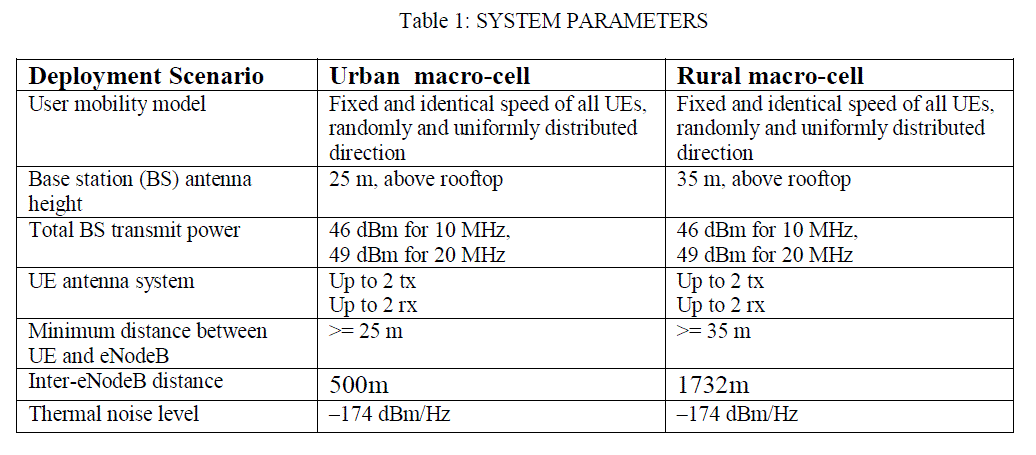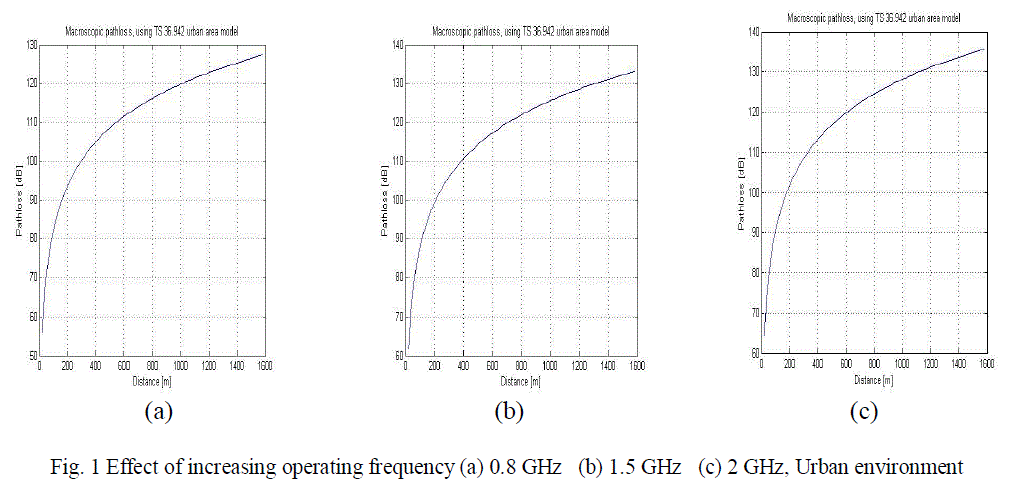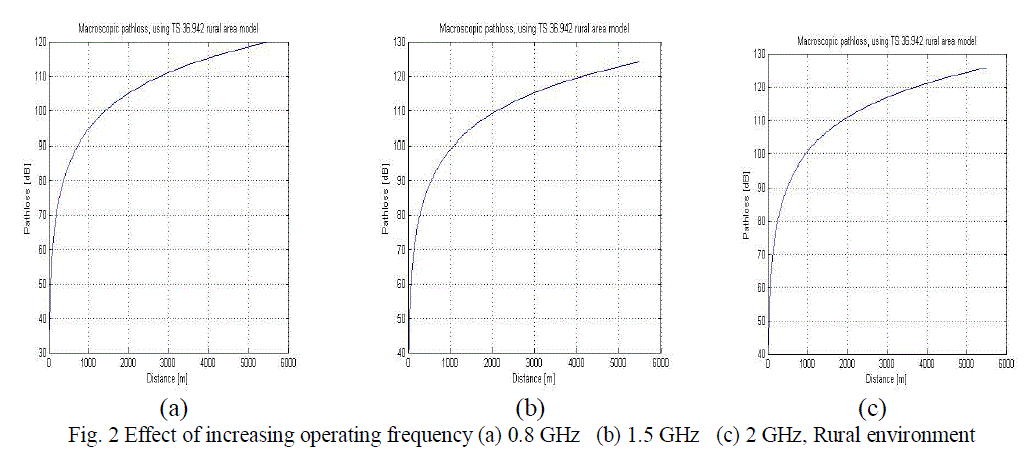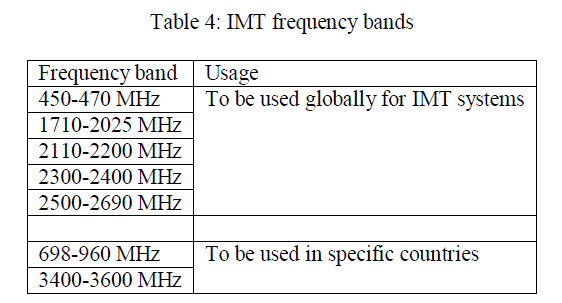A vast pool of frequency bands from 450 MHz to 3.6 GHz is available for deployment of LTE and LTEAdvanced networks. But with increase in the operating frequency path loss increases which in turn impacts the coverage area of a base station. Accordingly the number of base stations increases which leads to increase in the cost of deployment. Availability of spectrum in high frequency range is not an issue but it has its own pros and cons. This paper discusses the effects of deploying networks at high frequency versus deployment at low frequencies. The LTE system level simulator by Vienna has been used to study the changes in path loss with changes in operating frequencies of 0.8 GHz to 2 GHz.
Keywords |
| Long term evolution, operating frequency, path loss, rural and sub urban environment, Long term
evolution - Advanced. |
INTRODUCTION |
| Long Term Evolution (LTE) was a revolutionary step to achieve higher data rates than those offered by 3G cellular
systems. Data rates of upto 500Mbps in uplink and 1 Gbps in downlink were targeted by 3GPP group. For supporting
such speed, in late 2009, ITU received a proposal for considering LTE-Advanced as a candidate 4G system in the
mobile communication world. In March 2011, 3GPP had standardized LTE-Advanced [1] as an advancement to the
LTE technology. Various research proposals like relaying, CoMP, SU-MIMO and diversity MIMO, carrier
aggregation, Hybrid OFDMA and SCFDMA in uplink, ICICI etc. have been worked upon during the research phase
[2]. Amongst the requirements stated in the 3GPP technical report [3], main concentration was compatibility of the
LTE Advanced systems with the existing LTE networks. The study carried out by 3GPP has been discussed in [4]. |
| Network coverage is an important issue for the mobile cellular communication service providers. The deployment of
cellular systems takes into account the various propagation characteristics of the communication channel. There is a
vast diversity in the cellular environments. Those under study are the urban, rural and suburban, forest, sea etc. Suitable
radio propagation models describing the behaviour of signal travelling from transmitter to receiver have been discussed
over a long time in research papers [5-11]. Well known standard models are the COST 231-Hata, COST 231-Walfisch-
Ikegami, Hata-Okumura , Lee model etc. Loss that occur due to the travelling of signals from transmitter to receiver is
called the pathloss which is measured with the help of these propagation path loss models. |
| The document by 3GPP, a version of Release 10 [12], states the operating bands of E-UTRA systems. It states that the
frequency of operation of EUTRA systems extends from 699 MHz to 3.8 GHz in UL and 729 MHz to 3.8 GHz in DL
considering the FDD and TDD duplex modes. |
RESEARH WORK |
| The feature of usage of LTE in multiple bands of spectrum has been explored over a period of time. Studies have been
conducted for evaluating the performance of the system in various frequency bands. In [13] a thorough comparison of
system performance in 800 MHz band has been made with 1800 MHz band and UMTS 900 MHz band, considering few of the primary measurement parameters such as Referenced signal received power (RSRP), Referenced signal
received quality (RSRQ), Signal to Interference-noise ratio (SINR) and throughput. It emphasized the fact that
800MHz band provided twice the coverage than the 1800 MHz band with less number of base stations. The throughput
for LTE 800 is more than UMTS900 but with degradation towards the cell edges. The article by ZTE [14] discusses the
inherent features of the 700 MHz band for LTE technology. It reveals the fact that using a 700 MHz band ( in various
scenarios) the coverage provided by a single site is about 7-8 times that offered by the 2.6 GHz band, thereby requiring
very few sites operating at 700 MHz frequency. But the cost of having more number of sites operating at higher
frequencies is compensated by getting an increase in the capacity with such high frequency operation networks. Thus
operators building their networks on higher frequency of 1.7 GHz, 1.9GHz and 2.5 GHz would have higher capacity as
compared to those using the 700 MHz band. |
PROPAGATION LOSS |
| Free space path loss equation for far field situations is given as, |
 (1) (1) |
| Where, FSPL is the free space path loss, d is the distance of receiver from transmitter in metres, λ is the signal
wavelength in meters, f is the signal frequency in hertz and c is the speed of light in vacuum in meters per second.
Above equation shows that propagation loss of radio waves is frequency dependent and increases with frequency.
Higher frequency bands tend to have higher propagation losses. These losses are due to of many effects, such as freespace
loss, refraction, diffraction, reflection, aperture-medium, coupling loss, and absorption. Path loss is also
influenced by terrain contours, environment (urban or rural, vegetation and foliage), propagation medium (dry or moist
air). Propagation loss is calculated using different path loss models which depict the dependency of propagation loss on
both the distance ‘d’ between receiver and transmitter and the operating frequency. Discussion about the 3 kinds of
models: Empirical models, semi-deterministic model and the deterministic models have been done in [15]. Low
frequency signals tend to have less propagation losses as compared to high frequency signals. The section IV consists
of a detailed analysis to support the same. |
SIMULATION AND RESULTS |
| LTE system level simulator [16] has been used for determining the effect of increasing configuration frequency on the
overall performance of system both in rural and urban environment. The system parameters have been stated in the
table 1. The system layout consists of hexagonal grid of eNodeBs with 3 sectors/ eNodeB and randomly placed user
equipments (UE). |
 |
| The figure 1 shows the variations in path loss with distance for different configuration frequencies in urban
environment. Here due to dense distribution of the user equipments the ideal inter eNodeB distances should be 500
meters. It is seen from the figure that at the same distance of 500 meters the macroscopic path loss increases with the
increase in configuration frequency. |
 |
| The path loss occurring at different frequencies has been tabulated in the table 2. It shows that higher frequencies tend
to experience more path loss as compared to lower frequencies. A network operating at 800 MHz will have less path
loss as compared to the one using the 2 GHz band. A GSM system using 800 MHz band will tend to exhibit less
pathloss than LTE systems using the 2 GHz and higher frequency bands. Hence, for networks deployed at higher
frequencies the inter eNodeB distances in urban environment should be 500 meters to ensure that the channel quality is
good and the users get their desired quality of service. |
 |
| LTE-Advanced systems, an enhancement to the LTE systems, introduce the relaying technology to compensate these
path losses and boost up the signal strength between the base station and the user equipments. Here many low power
nodes are placed between the base station and UEs. These nodes process the signal to the desired strength and quality
and forward it to the next relay node or the UE in the link. This technique provides a good solution to the increased cost
involved in deploying high power eNodeBs for taking care of the path losses encountered in the communication link. |
| The figure 2 shows the effect of frequency on macroscopic path loss in rural environment. From the table it can be seen
that at the distance of about 2000 meters the path loss increases with increase in frequency. Ideally, the inter eNodeB
distance in rural environment should be 1732 meters. |
 |
| Table 3 shows the variations in the path loss at different frequencies for the rural environment. Networks in rural
environments tend to experience less path loss as compared to those in the urban environment as the signal experiences
less amount of diffraction, reflection, scattering and other such phenomenon which tend to decrease the signal strength
and hence increase the path loss. |
 |
| The coverage at 0.8 GHz, 1.5GHz and at 2.0 GHz, for the urban environment, for sector 1 eNodeB1, is shown in figure
3. It can be deduced that wider coverage is obtained at 0.8MHz than at 2GHz. This is because of signals of high
frequencies travel less distances as compared to lower frequency signals. Low frequency signals have deep penetration. |
 |
| Networks deployed in urban areas, where there are more obstacles, tend to exhibit more path losses at higher
frequencies than those deployed at rural areas. The figure 4 shows the coverage obtained in rural area at different
operating frequencies. Rural areas have less density of buildings so the signals do not undergo much penetration losses.
For a system operating at same frequency the signal strength is better in rural areas as compared to urban areas. Thus
selection of operating band has a significant effect on the coverage distance and the quality of service offered to the users. Operators would prefer to select an operating band which will provide them a large coverage as well as high
penetration capability and at the same time reducing their expenses with the use of fewer cell sites operating at low
frequency |
 |
| LTE – Advanced system, considers using frequency bands [17] as shown in table 4. The feature of flexibility of
combining multiple frequency bands (low as well as high frequency bands) to enhance the performance of the system
has become possible due to the technological component of carrier aggregation, a key component of LTE-Advanced
systems. Here with the use of contiguous and non-contiguous carrier aggregation techniques, over the entire spectrum,
a large bandwidth of 100 MHz is achieved which supports higher data rates (the key requirement of 4G systems), as
well as provide wider coverage using underlay and overlay schemes of deployment. |
 |
CONCLUSION |
| Mobile communication systems operate at frequencies ranging from 450 MHz to 3600 MHz. Different frequency bands
experience different propagation losses as per the mobile cellular environment. There is about 10 db of propagation loss
in urban environment and 8dB in rural environment as the operating frequency is increased from 800 MHz to 2 GHz.
As propagation losses increase due to various reasons mentioned before, the coverage of the network reduces. Hence
using lower operating frequency ensures wider coverage. This reduction in coverage area of a base station eventually
results in deployment of more base stations to cover a given area. A network deployed at 1900 MHz takes about 2-4
times as many sites as that deployed at 850 MHz. Thus deployment of LTE network at high frequency is costly but the
there is an improvement in the capacity of the system. The ratio depends upon various factors such as path loss, the link
budget, cell tower height, the terrain of the area being covered. In densely populated areas, low frequency sites can
cause inter cell interferences but down tilting the base station antenna can reduce the coverage and thereby the
interference. Thus, depending upon the requirement of the operator and the availability of the spectrum the providers
may deploy systems operating at higher or lower frequency bands. |
FUTURE WORK |
| In future, bands between 3-5 GHz and even 60 GHz will be utilized for mobile wireless communication [18]. In those
deployments, the higher propagation path losses encountered would be compensated by having an increased no. of cell
sites under the macro cell. Improved coordination mechanisms will have to be worked upon. Further research would be
carried out for exploring the features of higher frequency bands as well as lower [<700 MHz] bands and studying the
various parameters affecting propagation characteristics of these bands. LTE-advanced system environment will be
considered for research work. |
References |
- S. Parkvall, E. Dahlman, A.FuruskÃÆär et al; Ericsson, Robert Syputa, Maravedis, âÃâ¬ÃÅITU global standard for international mobile telecommunications ÃâôIMT-AdvancedÃâô; LTE Advanced - Evolving LTE towards IMT-AdvancedâÃâ¬ÃÂ, Vehicular Technology Conference, VTC 2008-Fall. IEEE 68th 21-24 Page(s):1 âÃâ¬Ãâ 5, 2008.
- S. Sesia, I. Toufik, and M.Baker, âÃâ¬ÃÅLTE - The UMTS Long Term Evolution- from Theory to PracticeâÃâ¬ÃÂ, John Wiley & Sons, ISBN 978-0-470- 69716-0.
- 3GPP TR 36.913, âÃâ¬ÃÅRequirements for further advancements for EUTRA (LTE-Advanced)âÃâ¬ÃÂ.
- B. Furht, S. Ahson, "Long Term Evolution: 3GPP LTE Radio and Cellular Technology", Crc Press, 2009, ISBN 978-1-4200-7210-5.
- T.Sarkar, Z. Ji, K. Kim, A. Medouri and M. Salazar-palma, âÃâ¬ÃÅ A Survey of various propagation models for mobile propagationâÃâ¬ÃÂ, IEEE Antenna and propagation magazine, vol. 45, No. 3, June 2003.
- N. Beaunstain, âÃâ¬ÃÅPrediction of cellular characteristics for various urban environments,âÃâ¬Ã IEEE Antennas and propagation magazine, Vol. 41, No. 6, pp. 135-145, 1999.
- S. Ichitsubo, T. Furuno, T. Taga and R. Kawasaki, âÃâ¬ÃÅMultipath propagation model for line of sight street microcells in urban areaâÃâ¬ÃÂ, IEEE transactions on Vehicular Technology, VT-49, No. 2, pp. 422-427, 2000.
- Y. Okumura, E. Ohmori, T. Kawano, and K. Fukuda, âÃâ¬ÃÅField strength and its variability in the VHF and UHF land mobile serviceâÃâ¬ÃÂ, Review Electronic Communication Laboratories, 16(9/10), pp. 825âÃâ¬Ãâ873, 1968
- M. Hata. âÃâ¬ÃÅEmpirical formula for propagation loss in land mobile radio servicesâÃâ¬ÃÂ, IEEE Transactions on Vehicular Technology, vol. VT-29, pp. 317âÃâ¬Ãâ325, 1981.
- COST Action 231, âÃâ¬ÃÅDigital mobile radio. Towards future generation systemsâÃâ¬ÃâFinal reportâÃâ¬Ã European Communities, Tech. rep. EUR 18957, Ch. 4., 1999.
- F. Ikegami, S. Yoshida, T. Tacheuchi and M. Umehira, âÃâ¬ÃÅ Propagation Factors controlling Mean Field Strength on Urban StreetsâÃâ¬ÃÂ, IEEE Trans., AP32(8), 822-9.1984.
- ETSI TS 136 101 V10.3.0 (2011-06) âÃâ¬ÃÅLTE; Evolved Universal Terrestrial Radio Access (E-UTRA);User Equipment (UE) radio transmission and reception (3GPP TS 36.101 version 10.3.0 Release 10)âÃâ¬ÃÂ.
- P. Sainju, âÃâ¬ÃÅLTE performance analysis on 800 and 1800 MHz bandsâÃâ¬ÃÂ, Thesis for Master of Science at Tampere university of technology, 2012.
- ZTE, âÃâ¬ÃÅAPT 700 MHz, Best choice for nationwide coverageâÃâ¬ÃÂ, 2013.
- S. Ranvier, âÃâ¬ÃÅPath Loss Models, S-72.333 Physical layer methods in wireless communication systemsâÃâ¬ÃÂ, 2004.
- http://www.nt.tuwien.ac.at/research/mobile-communications/lte-downlink-system-level-simulator/
- Radio Regulations, International Telecommunication Union Std., November 2012. [Online] Available: http://www.itu.int/pub/RREG-RR/en.
- I. Akyildiz , D.Gutierrez-Estevez, R. Balakrishnan, and E. Chavarria-Reyes âÃâ¬ÃÅLTE-Advanced and the evolution to Beyond 4G (B4G) systemsâÃâ¬ÃÂ, Elsevier, Physical Communication, 2013.
|